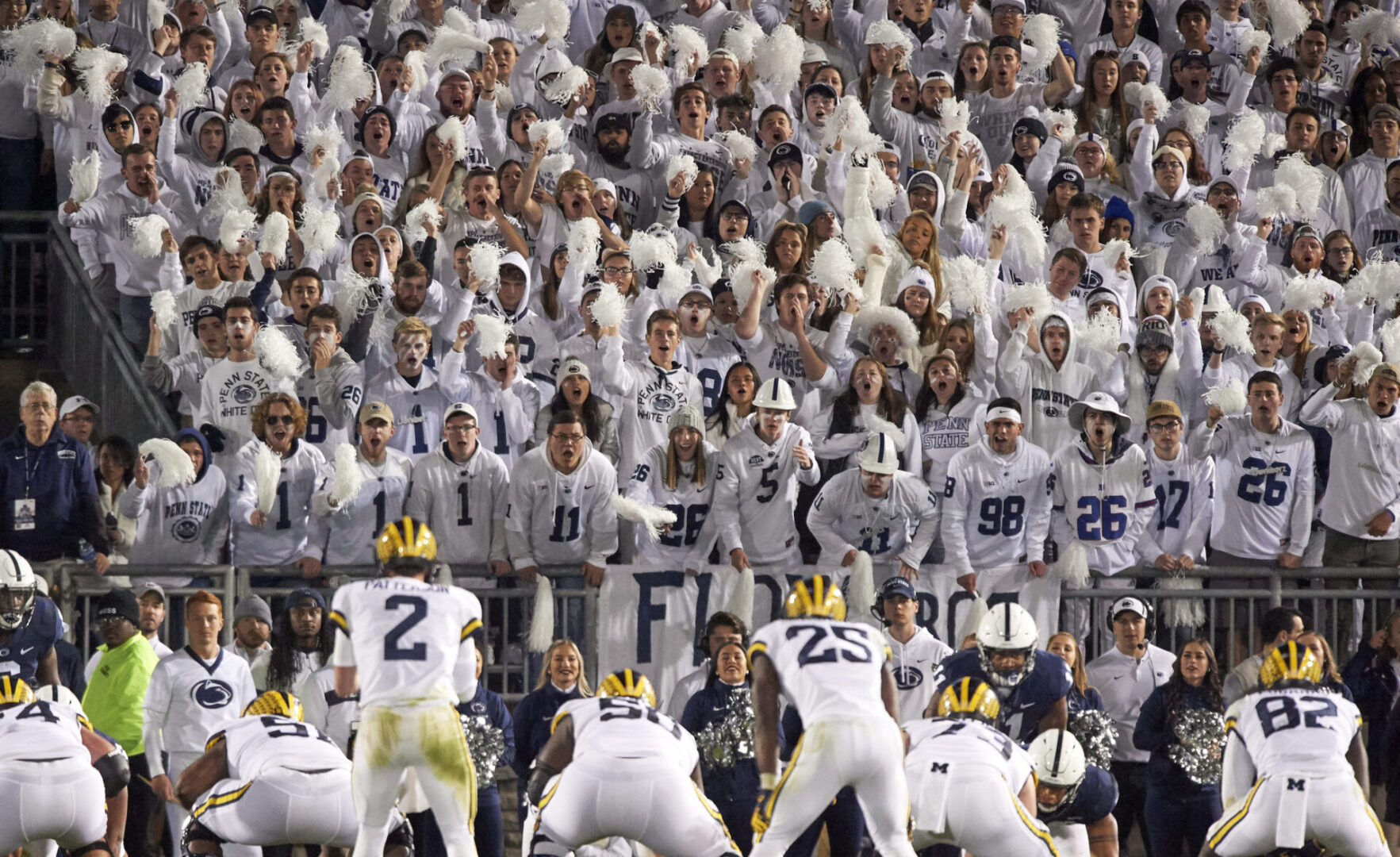Even with 100,000-plus people packing Beaver Stadium on home football Saturdays this fall, Dana Crouse should be easy enough to spot.
Chances are, you’ll find her leaning out a second-floor window of the press box from time to time, listening to the crowd.
As the director of marketing and fan experience for Penn State football, Crouse leads a team that works to “create memories” for fans as they, in turn, try to propel the Nittany Lions to victory on the field.
The group putting on that show includes marketing staffers; DJs; public address announcers; camera, video, and graphics ops; and the band and spirit squads, as well as consultant Guido D’Elia, famed as architect of the White Out.
The preparation begins as soon as the prior season’s bowl game concludes, Crouse says.
“Once that bowl game is over, we are diving into planning for the following season,” she says. “What did we like? What did we not like? Where do we need to get better at something? As a production team, we do our own game film; we record the video board and the fans and what that experience looks like for them. And then we watch it back on Sunday [after each game]. We’re watching to see what worked and what didn’t and where we can be better.”
For example, the fan experience team looks at what music the crowd responds best to, balancing traditional favorites while giving some new songs a try.
“I’m normally the crazy person hanging out the window of the press box on the second floor, listening to the crowd, getting that feel for, are they reacting to this or not?” she says.
Crouse, a 2013 Penn State grad, also is in charge of fan experience for men’s hockey at Pegula Ice Arena. She has worked at Penn State for 10 years, after interning at Pegula, and had a hand in developing the fan experience there as the Nittany Lions moved to the NCAA Division I level.
After being involved in on-field activities and team arrival for football at Beaver Stadium, Crouse took over directing the fan experience there in 2017, working at first in tandem with PJ Mullen until his departure in 2021.

Here’s more from our conversation:
The first game is at night; you’ve got a couple of those in September. Is the approach to a night game different—especially the White Out where the crowd is really pumped up—versus, say, a noon game against Delaware, where maybe it’s not quite the same level of intensity with the crowd?
Crouse: Prep-wise, we’re treating all seven games the same, trying to go 1-0 each week, right? But once you’re in that game, we’re reacting to what’s happening.
We’re always trying to push [the fans]; part of our job is to react off of them. Part of our job is, if they’re high, to keep them high and push them even higher. If they’re maybe not at that moment, early on in a noon game, that’s on us to get them engaged and get them involved. We’re really fortunate here at Penn State that our crowd is super-knowledgeable about football; they know that they have an impact on the games and they want to impact the game.
What are the sure-fire songs that get people going?
Crouse: Mo Bamba has become one of those over the past few years. That’s a “save-it-for-a-big-moment, we-really-need-this-stop-on-D” kind of thing to really get the crowd going. We have some of our old standbys that they always participate with or sing along with, like Sweet Caroline. A feel-good sing-along is probably going to happen after we score a touchdown, [during a] media timeout.
We’re trying to create those experiences for our fans, creating memories for them. So, how do we help you create those memories? But in addition, if you came to the game, you came for a reason. You want to participate. You want to feel that bond with the strangers who are all wearing blue and white with you and feel like you’re a part of this common experience.
How do you strike the balance between 20,000 students in the stadium, the band, the players, and the rest of the crowd, where many fans are older?
Crouse: I think that’s everybody’s biggest challenge, across venues, across sports. And that’s what we talk about a lot here. It’s not my job to get the team going. It’s my job to get the fans going, which, in turn, the team feeds off of.
When the team is out on the field warming up for about the hour before kickoff, you’ll hear more player choice [in music]. We have a DJ on the field down there with them. We skew more heavily toward their stuff during that time, though not one hundred percent since the stands are filling with 100,000 people.
But once [warmups are] over, it’s up to us and how we get the crowd to react. We’re always looking for the music that people participate to, a certain beat that you can see the shakers going to. We joke a lot, but wedding music, for whatever reason, seems to also work at sporting events.
That’s actually part of our preseason practice. We are scrubbing through the music playlists. Was this a one-year song that no one’s really singing along with anymore? Let’s scrap it. What’s the new thing out there? How do we incorporate that, still keeping some of the old reliables, and where does that all blend together?
One complaint I’ve heard from some fans is that there is too much piped-in noise at times. Do you hear that?
Crouse: We hear feedback from everybody. It’s one of those things that we hear it, we take it in; what we’re able to adjust, we adjust. We’re always working to try to make sure that that experience is good for everybody. Everybody has different opinions, though, so sometimes that can be a little challenging. But that’s something we’ve talked about and have recognized over the years, is more listening to the crowd. If a play didn’t go our way, they kind of want that moment to exhale or sigh or whatever. And so, give them that, give them that moment, but then get them right back ready for that next down.
Take us through a game day. What are you doing?
Crouse: In our production booth alone, we have our PA announcers [there are two new Beaver Stadium voices this year, Rodney Martin and Joe Putnam] and their spotters for the information of what’s going on during the game. We have our in-game DJs upstairs with us, our video board graphics guy is upstairs with us, fireworks [along with live video feed production housed across the street in the Bryce Jordan Center]. And then there’s a few of us calling things. … And we’re calling not only what’s happening at media timeouts, but also we’re calling out the music. So, we’re saying, “Hey, if we get this first down on offense, we’re going to the band; the band’s taking us down the field here. Second down, we’re going with this song instead.”
We are, in our own ways, our own kind of coordinators for offense and defense, but for our game presentation and our fan experience. “Hey, we really need a stop here, let’s get ready for the crowd prompt, cue the crowd prompt, let’s roll it on the board.” All those kinds of things are happening and we’re coordinating the audiovisuals and what our fans are experiencing.
We are constantly talking over headsets, calling out what’s going on. And then there’s a counterpart of mine who’s thinking ahead to the media timeout, if we’re going to go business and some of the sponsorship elements; or if it’s going Penn State’s way, we’re probably not going to do that [at that time]. And then I’m going to call for the band to do something or we’re going to do Sweet Caroline or the Lion’s going to perform or the Lionettes. So, we’re also thinking ahead to those next breaks and those next elements.
One of the more memorable crowd moments in recent years was the White Out game [in 2019] where Michigan had to call timeout before the first play because the crowd was so loud. When something like that happens, are you guys up there high-fiving?
Crouse: At the end of the day, that’s the best-case scenario for us. Everything up until kickoff is completely scripted down to the second for our fans, how we’re trying to build your emotion and your anticipation at kickoff. And then we do talk each week about, “OK, if we come out on offense for that first drive, what are we doing? If we come out on defense, what are we doing?” To be honest, up in the booth, we’re probably hoping for defense because we’ve just gotten the crowd into a frenzy for kickoff [and the offense prefers quiet while calling signals at the line].
So, in that Michigan game, we actually got to come out on defense and we had a plan to play Mo Bamba; it was the first time we had reintroduced it from a previous game the year before. And we hit them with a player crowd prompt with one of our guys up on the board, like, “Here we go! Let’s go!” That’s normally reserved for third downs, bigger moments like that, but it was like, “Let’s just capitalize on the fact that this crowd is going to be insane going into that first play. How do we push them to that point even a little further?” And Michigan wasn’t ready for it.
I think back to last year’s White Out against Minnesota; they had two false starts [penalties] in a row. Those are huge wins for us. For the past few years, we have kept a tally, if you will, of those moments, and the way the crowd has impacted a game. This year, we’re actually going to count the yardage our fans get for us. And then also those timeouts, because those are a big part of it too. Our crowd is so knowledgeable; they’re so great at what they do. We want to recognize them for that and recognize their impact on the game.
Those are things that we definitely take pride in.
Watch the opening of the 2019 White Out game, where frenzied fans spurred a Michigan timeout. T&G
Mark Brackenbury is a former editor of Town&Gown.




